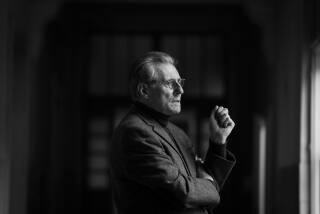Review: Lauren Groffâs âFates and Furiesâ turns the struggles of marriage into art
A marriage is its own enclosed universe, and no one except the two people within it can know its complexities, from its wordless shorthand and built-up resentments to its ingrained loyalty and tenderness.
But thatâs real life. Fiction, thankfully, lets us experience and learn from the lives of others. âFates and Furies,â Lauren Groffâs audacious and gorgeous third novel, offers readers such access by depicting over two decades between a husband and wife. The result is not only deliciously voyeuristic but also wise on the simultaneous comforts and indignities of romantic partnership. Marriage isnât always what it seems, even to those inside it.
Our players, Lotto and Mathilde, marry in secret after a two-week courtship. Itâs the tail end of their senior year at Vassar, and Lotto is the campusâ best actor and a popular ladiesâ man. Mathilde is quiet and mysterious, without any close friends. In the first scene, he and Mathilde make love on the beach as a newly married couple. It is Lottoâs unassailable confidence in their union that is most striking: âHe could die right now of happiness,â Groff writes. Lotto sustains this certainty in their marriage, and in Mathilde, whom he sees as âthe nexus of all the good of this world,â for almost the entire novel.
SIGN UP for the free Essential Arts & Culture newsletter >>
Early in their marriage, Lotto flails as an actor as Mathilde supports them; they throw parties in their New York City basement apartment; they make love. When Mathilde discovers a play Lotto has written in a drunken New Yearâs Eve haze, she declares he has a gift and nurtures it. His first play is a success, and itâs not long before he has a dazzling career as a gifted playwright.
To show so much of Lotto and Mathildeâs lives, Groff makes chronological jumps â a month here, a year there â that are occasionally confusing. The disorientation, however, lasts only for a sentence or two as the reader gets her bearings; in general, the movements forward are efficient and poignant, emphasizing how aging simultaneously changes us and reaffirms our biggest flaws.
In her previous work, including the 2012 novel âArcadia,â Groff proved herself a deft prose stylist, translating the familiar into the remarkable and transcendent. âFates and Furiesâ further showcases this talent. Take this line, for instance, describing a pastoral view at dawn: âHot milk of a world, with its skin of morning fog in the window.â The lyricism differentiates and elevates Lotto and Mathildeâs coupledom, and the reader leans in closer, to find out more. If once or twice the poetry obfuscates rather than clarifies, itâs to be forgiven; as with love, the exceptional is preferable to the mundane.
In the bookâs first half, the reader comes to know Lottoâs vanity and his confidence in the world as he has narrated it. Mathilde herself is vivid on the page, if somewhat enigmatic. Thereâs a sense that she isnât wholly who Lotto believes her to be. Groff allows for further discrepancy with the use of bracketed narration, which riffs on and editorializes the storyâs proceedings. These lines, such as â[Perhaps we love him more like this. Humbled.]â function as a kind of Greek chorus, one that understands more about the characters than the characters themselves.
Midway through, the novelâs structure changes, and we get access to Mathilde. Her story isnât chronological but shattered, and her history is revealed gradually between epigrammatic present scenes. It turns out, she is and is not the wife we met at the bookâs opening.
As Gillian Flynn did in âGone Girl,â Groff recasts the narrative midway through to depict a woman who has curated her marital identity. Mathilde has done so not out of sociopathy but out of self-protection and as a way to preserve her husbandâs innocence. Also unlike Flynnâs novel, what emerges in âFates and Furiesâ is an expansion to the husbandâs narrative rather than a corrective. Groffâs retelling of certain key scenes is subtle, and the distinctions resonate.
The structure of âFates and Furiesâ emphasizes how differently two people can experience the same marriage, even as they continue to love each other deeply. Both Lotto and Mathilde wrestle themselves and each other into defined roles and stories. To Lotto, he is destined for greatness, and his wife is a saint. Mathilde understands his need for this legend and willingly plays the part, never revealing the flawed parts of herself and her past. Early on, itâs remarked, âWomen in narratives were always defined by their relations,â and itâs as if the second half of the book exists to dramatize this statement. Of Mathilde, Groff writes, âThe story of women is the story of love, of foundering into one anotherâŚ. Forgive her if she believed this would be the way it would go. She had been led to this conclusion by forces greater than she.â
Perhaps, Groff suggests, itâs not as easy to be a wife as it is to be a husband.
The stories we tell ourselves and others give our lives meaning and allow us to connect with those closest to us. These stories can also mislead, disappoint, and hold us back from being our true selves, selves that belie legible narratives. In âFates and Furies,â Lauren Groff has taken the struggles and pleasures of marriage and turned them into art, and in that artfulness she reminds us of the dangers and omissions that any storytelling requires.
::
Fates and Furies
A Novel
Lauren Groff
Riverhead: 400 pp., $27.95
Lepucki is the author of the novel âCalifornia,â now out in paperback.
More to Read
Sign up for our Book Club newsletter
Get the latest news, events and more from the Los Angeles Times Book Club, and help us get L.A. reading and talking.
You may occasionally receive promotional content from the Los Angeles Times.







